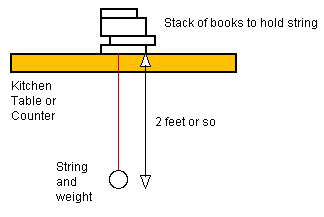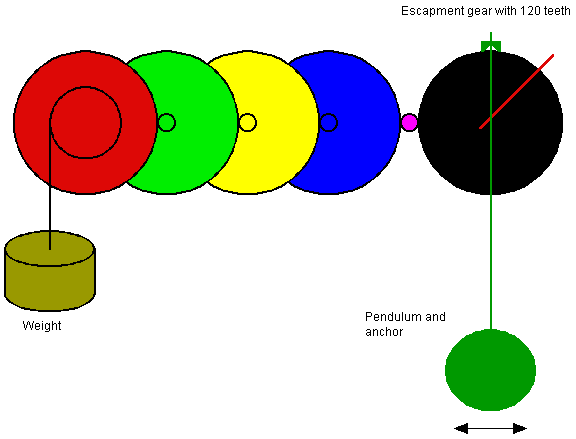

How
Pendulum Clocks Work
by
Marshall
Brain
 Have you ever looked inside a grandfather clock or a small
mechanical
alarm clock, seen all the
gears and springs and thought, "Wow - that's complicated!"? While
clocks normally are fairly complicated, they do not have to be
confusing or mysterious. In fact, in learning how a clock works you
can see how clock designers faced and solved a number of interesting
problems in order to create accurate timekeeping devices. This will
help you understand what makes clocks tick (:-)) so the next time you
look inside one you can make sense of what's happening!
Have you ever looked inside a grandfather clock or a small
mechanical
alarm clock, seen all the
gears and springs and thought, "Wow - that's complicated!"? While
clocks normally are fairly complicated, they do not have to be
confusing or mysterious. In fact, in learning how a clock works you
can see how clock designers faced and solved a number of interesting
problems in order to create accurate timekeeping devices. This will
help you understand what makes clocks tick (:-)) so the next time you
look inside one you can make sense of what's happening!
Pendulum clocks have been used to keep time since 1656, and they have not changed dramatically since then. Pendulum clocks were the first clocks made to have any sort of accuracy. When you look at a pendulum clock from the outside you are aware of several different parts that are important to the mechanism of all pendulum clocks:
So let's start with the weight and see what it is doing. The idea behind the weight is to act as an energy storage device so that the clock can run for relatively long periods of time unattended. When you "wind" a weight-driven clock, you pull on a cord that lifts the weight. That gives the weight "potential energy" in the Earth's gravitational field. As we will see in a moment, the clock uses that potential energy as the weight falls to drive the clock's mechanism.
 So let's say that we wanted to use a falling weight to create the
simplest possible clock -- a clock that has just a second hand on it.
We want the second hand on this simple clock to work like a normal
second hand on any clock, making one complete revolution every 60
seconds. We might try to do that, as shown in the figure on the left,
simply by attaching the weight's cord to a drum and then attaching a
second hand to the drum as well. This, of course, would not work. In
this simple mechanism, releasing the weight would cause it to fall as
fast as it could, spinning the drum at about 1,000 RPMs until the
weight clattered on the floor.
So let's say that we wanted to use a falling weight to create the
simplest possible clock -- a clock that has just a second hand on it.
We want the second hand on this simple clock to work like a normal
second hand on any clock, making one complete revolution every 60
seconds. We might try to do that, as shown in the figure on the left,
simply by attaching the weight's cord to a drum and then attaching a
second hand to the drum as well. This, of course, would not work. In
this simple mechanism, releasing the weight would cause it to fall as
fast as it could, spinning the drum at about 1,000 RPMs until the
weight clattered on the floor.
Still, it's headed in the right direction. Let's say we put some kind of friction device on the drum -- some sort of brake pad or something that would slow the drum down. This might work. We would certainly be able to devise some scheme based on friction to get the second hand to make approximately one revolution per minute. Unfortunately it would only be approximate. As the temperature and humidity in the air changes, the friction in the device would change. Thus our second hand would not keep very good time.
So, back in the 1600's people who wanted to create accurate clocks were trying to solve the problem of how to cause the second hand to make exactly one revolution per minute. The Dutch astronomer Christiaan Huygens is credited with first suggesting the use of a pendulum. Pendulums are useful because they have an extremely interesting property. The period (the amount of time it takes for a pendulum to go back and forth once) of a pendulum's swing is related only to the length of the pendulum and the force of gravity. Since gravity is constant at any given spot on the planet, the only thing that affects the period of a pendulum is the length of the pendulum. The amount of weight does not matter. Nor does the length of the arc that the pedulum swings through. Only the length of the pendulum matters.
You can prove this fact to yourself by performing the following experiment. For this experiment you will need a weight, a string, a kitchen table and a watch with a second hand (or a numeric seconds display on a digital watch). For the weight you can use anything to which you can easily tie your string. In a pinch a coffee mug will do - it doesn't really matter. Tie the string to the weight. Then suspend your pendulum over the edge of the table so that the length of the pendulum is about 2 feet long, as shown here:

Now pull the weight back about a foot and let your pendulum start swinging. Time it for 30 or 60 seconds and count how many times it swings back and forth. Remember that number. Now stop the pendulum and restart it, but this time pull it back only 6 inches initially so it is swinging through a much smaller arc. Count the number of swings again through the same 30 or 60 second time period. What you will find is that the number you get is the same as the first number you counted. In other words, the angle of the arc through which the pendulum swings does not affect the pendulum's period. Only the length of the pendulum's string matters. If you play around with the length of your pendulum you will find that you can adjust it so that it swings back and forth exactly 60 times in one minute.
 Once someone noticed this fact about pendulums, it was realized that
you could use the phenomena to create an accurate clock. The figure
to the right shows how you can create a clock's escapement
using a pendulum. In an escapement there is a gear with teeth of some
special shape. There is also a pendulum, and attached to the pendulum
is some sort of device to engage the teeth of the gear. The basic
idea that is being demonstrated in the figure is that, for each swing
of the pendulum back and forth, one tooth of the gear is allowed to
"escape".
Once someone noticed this fact about pendulums, it was realized that
you could use the phenomena to create an accurate clock. The figure
to the right shows how you can create a clock's escapement
using a pendulum. In an escapement there is a gear with teeth of some
special shape. There is also a pendulum, and attached to the pendulum
is some sort of device to engage the teeth of the gear. The basic
idea that is being demonstrated in the figure is that, for each swing
of the pendulum back and forth, one tooth of the gear is allowed to
"escape".  For example, if the pendulum is swinging toward the left and passes
through the center position as shown in the figure on the left, then
as the pendulum continues toward the left the left-hand stop attached
to the pendulum will release its tooth. The gear will then advance
one-half tooth's-width forward and hit the right-hand stop. In
advancing forward and running into the stop, the gear will make a
sound... "tick" or "tock" being the most common. That is where the
ticking sound of a clock or watch comes from!
For example, if the pendulum is swinging toward the left and passes
through the center position as shown in the figure on the left, then
as the pendulum continues toward the left the left-hand stop attached
to the pendulum will release its tooth. The gear will then advance
one-half tooth's-width forward and hit the right-hand stop. In
advancing forward and running into the stop, the gear will make a
sound... "tick" or "tock" being the most common. That is where the
ticking sound of a clock or watch comes from!
One thing to keep in mind is that pendulums will not swing forever. Therefore, one additional job of the escapement gear is to impart just enough energy into the pendulum to overcome friction and allow it to keep swinging. To accomplish this task, the anchor (the name given to the gizmo attached to the pendulum to release the escapement gear one tooth at a time) and the teeth on the escapement gear are specially shaped. The gear's teeth escape properly, and in addition the pendulum is given a nudge in the right direction by the anchor each time through a swing. The nudge is the boost of energy that the pendulum needs to overcome friction, so it keeps swinging. The following figure shows the shape of the anchor and escapement wheel used in the book "Make Your Own Working Paper Clock":

So, let's say that you create an escapement like this. If you gave the escapement gear 60 teeth and attached this gear directly to the weight drum we discussed above, and if you then used pendulum with a period of one second, you would have successfully created a clock in which the second hand turns at the rate of one revolution per minute. By adjusting the pendulum's length very carefully we could create a clock with very high accuracy.
While accurate, this clock would have two problems that make it less-than-useful:
The second problem is easy to solve. As discussed in the How Stuff Works article on gears, you can create a high-ratio gear train that causes the drum to make perhaps one turn every 6 to 12 hours. This would give you a clock that you only had to rewind once a week or so. The gear ratio between the weight drum and the escapement gear might be 500:1 or so, as shown in the diagram below:

In this diagram the escapement gear has 120 teeth, the pendulum has a period of 1/2 second and the second hand is connected directly to the escapement gear. Each gear in the weight's gear train has an 8:1 ratio, so the full train's ratio is 492:1.
You can see that if you let the escapement gear itself drive another gear train with a ratio of 60:1, then you can attach the minute hand to the last gear in that train. A final train with a ratio of 12:1 would handle the hour hand. Presto! You have a clock!
Now this clock is nice, but it has 2 problems:
You can see that, even though all the gears in a clock make it look complicated, what a pendulum clock is doing is really pretty simple. There are 5 basic parts:
Once you understand these pieces, clocks are a piece of cake!
Here's a set of questions from readers: